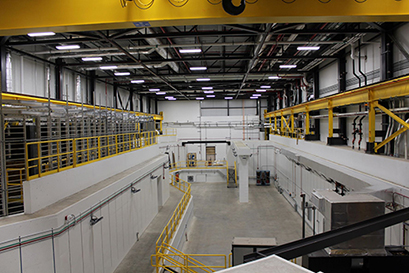
Michigan State University is getting ready to build a multimillion dollar new research tool. The U.S. Department of Energy’s Office of Science (DOE-SC) has approved $49.7 million for a high-tech scientific instrument at the university’s research Facility for Rare Isotope Beams (FRIB). The High Transmission Beam Line project is the latest investment in a facility that has already received more than $1.5 billion in federal funding since 2012.
The new beam line system uses 12 powerful magnets weighing a combined 640,000 pounds to transport rare atomic particles at roughly half the speed of light. This allows scientists to create thicker targets where the particles collide, significantly increasing the chances of producing the specific rare particles they want to study.
The new beam line is part of a larger scientific instrument called the High Rigidity Spectrometer that will dramatically enhance the facility’s research capabilities. This approval continues DOE’s investment in cutting-edge scientific equipment that keeps America at the forefront of nuclear physics research. The facility is also a testing ground for microelectronic components like semiconductors, a critical piece of technology in the supply chain for virtually all electronic devices.
This investment comes at a crucial time when understanding the fundamental building blocks of matter has far-reaching implications for everything from medical treatments to space exploration. The facility essentially allows scientists to study exotic versions of elements that typically only exist for fractions of a second during explosive events in stars, providing insights into how the elements in our universe were created.
When the new beam line is in place, FRIB will increase its ability to study these rare atomic particles by up to 100 times, giving unprecedented research capabilities to a large research group centered at Michigan State that includes 500 scientists from 21 U.S. universities, five national laboratories and international research centers in Canada, Germany, Japan and the United Kingdom.
In a press release, FRIB Laboratory Director Thomas Glasmacher expressed gratitude and said the advanced research is “made possible by the continued support of the federal government and the American public, whose investment in basic research is vital to advancing knowledge for American competitiveness.”
Even on its own, the beam line provides valuable scientific opportunities. It will allow researchers to better understand the strong nuclear force that binds protons and neutrons together to form the nuclei of atoms – the same force that produces energy in stars and nuclear power plants.
The complete High Rigidity Spectrometer project, spanning over 230 feet when finished, will include additional magnets in its second section. Two of these will be the largest magnets ever built at FRIB, weighing over a million pounds each.
This latest approval follows DOE’s September 2023 award of $115 million for the overall spectrometer project, part of a series of major investments in FRIB that include $529 million awarded July 2023 for operations after the facility’s completion and $199 million previously awarded for early operations.
FRIB’s impact extends beyond pure science into economic development and workforce training. Since 2011, FRIB has invested over 94% of its procurement and labor spending in the United States, with 78% in Michigan. The facility currently employs 565 staff members and provides research opportunities for nearly 300 students.
The facility also addresses critical national needs in semiconductor testing. FRIB’s specialized testing facility has served 41 companies researching microchips for spaceflight, wireless technology and autonomous vehicles. In 2024, the federal government awarded an additional $14 million to establish a new chip testing facility that will repurpose MSU’s 1980s-era particle accelerator for testing how electronics respond to conditions similar to those in space.
The beam line project is scheduled to be completed in 2030.
Photo Courtesy Michigan State University
The post Michigan State secures $49.7 million for advanced physics research tool appeared first on Government Market News.
